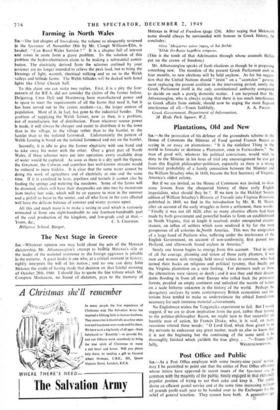Farming in North Wales
Si .—The last chapter of Snowdonia, the volume so eloquently reviewed in the Spectator of November 18th by Mr. Clough Williams-Ellis, is beaded: Can Rural Wales Survive ? " It is a chapter full of interest and raises in acute form a grave problem. To the solution of this problem the hydro-electricians claim to be making a substantial contri- bution. The electricity derived from the schemes outlined by your reviewer arc no longer intended to relieve the peak load, but to bring the blessings of light, warmth, electrical milking and so on to the Welsh valleys and hillside farms. The Welsh hillsides will be decked with festal lights like Christ Church hall.
To this claim one can make two replies. First, it is a pity the fore- runners of the B.E.A. did not consider the claims of the farmer before. Dolgarrog, Cwm Dyli and MaentwrOg have manufactured power and to spare to meet the requirements of all the farms that need it, but it has been served out to the easiest markets—i.e., the larger centres of population. Most of it, in fact, has gone to the industrial border. The problem of supplying the Welsh farmer, now as then, is a problem, not of manufacture, but of distribution. From whatever source power is made, it will always be cheaper and easier to distribute it to the town than to the village, to the village rather than to the hamlet, to the
hamlet than to the isolated farmstead. Unfortunately the pattern of Welsh farming is based on the isolated farmstead and not on the hamlet.
Secondly, it is idle to give the farmer elefitricity with one hand and to take away his water with the other. Over a great part of North Wales, if these schemes were put into operation, every available drop of water would be captured. As soon as there is a dry spell the Ogwen, the Gwynant, the Colwyn and countless less well-known streams would be reduced to mere trickles. It is clear that the same water cannot be doing the work of agriculture and of electricity at one and the same time. If it is canalised in leats, pipelines and tunnels it cannot also be feeding the springs and watering the meadows. Some of the farms will be drowned, others will have their sheepwalks cut into two by monstrous leafs twelve feet wide, which will be an eyesore to man in the summer and a pitfall to beast in the winter, and all who farm in the area affected will have the delicate balance of summer and winter pasture upset.
All this and much more is to make a saving in coal which is variously estimated at from one eight-hundredth to one fourteen-hundredth part of the coal production of the kingdom, and low-grade coal at that.—


































 Previous page
Previous page